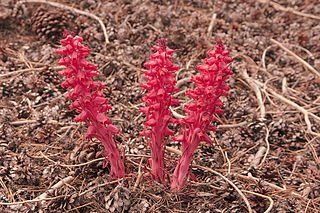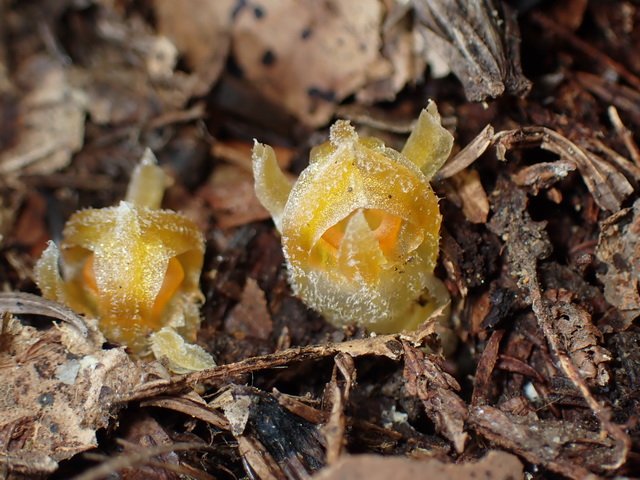Unexpectedly, the cheating plant Thismia kobensis still exists
It was discovered in 1992 and believed to be extinct because the site where it had been found was destroyed in 1999. But now, it is rediscovered elsewhere: the Kobe fairy lantern. Kenji Suetsugu and colleagues describe the beautiful but cheating tiny plant.
You would hardly recognize them as plants, the small, splendid ‘fairy lanterns’ on the forest floor, often hidden under fallen tree leaves. Fairy lanterns, Thismia species, are indeed remarkable plants. What you see are the flowers, less than a centimeter in size. The plants have no green leaves, only some scales on the very short stem. Most of the plants lives underground.
There are about 90 species, one of which is Thismia kobensis, the Kobe fairy lantern. Small and inconspicuous as it is, it was only discovered in 1992, in an oak forest near the Japanese city of Kobe. The find was small: it consisted of no more than one specimen. The site was destroyed in 1999 when an industrial complex was constructed, and the newly discovered species went extinct. That was what people thought. But fairy tales exist: in 2021 biologists unexpectedly rediscovered the plant on a conifer plantation in the town of Sanda, 30 kilometers from the original site. And this time the find was larger: almost 20 individuals. Now, Kenji Suetsugu and colleagues provide a scientific description of the species.
The loveliness of its flower is deceptive: Thismia kobensis belongs to a group of cheating plants.
Energy requirement
The cheating has to do with the lack of green leaves.
The green leaves of normal plants contain many chloroplasts. In these cellular organelles, photosynthesis takes place: plants extract carbon dioxide from the atmosphere and with the help of sunlight they fix the carbon in carbohydrates such as sugars and starch. From these carbohydrates, they derive energy. Plants without green leaves cannot make carbohydrates, but they do need energy.
Many of these plants solve this problem by extracting sugars with their roots from fungi in the soil. The scientific term for this is mycoheterotrophy.
Fairy lantern is sugar thief
Most mycoheterotrophic plants target fungi that live in a mutualistic relationship with green plants. The fungi get sugars from these plants. In return, the fungi help the green plants to absorb water and nutrients such as nitrogen and phosphorus from the soil. This collaboration, called mycorrhiza, is mutually beneficial and both parties are honest.
However, when mycoheterotrophic plants such as Thismia make contact with mycorrhizal fungi, they don’t cooperate in this way. They do receive water and nutrients, but they do not return sugars. They can’t. Instead, they take up sugars from the fungus in addition to water and nutrients. In other words: they steal. The fungus had received those sugars from green plants, so mycoheterotrophic plants indirectly parasitize on green plants via mycorrhizal fungi.
Difficult alternative
There are about 500 species of mycoheterotrophic plants. They live on nutrient-poor soils in forests, where little sunlight reaches the soil and the ability for photosynthesis, i.e., sugar production, is limited. Sugar theft is the alternative that these plants developed.
 But it’s not as easy as it seems. It is difficult for a mycoheterotrophic plant to form a relationship with a mycorrhizal fungus. Where a green plant interacts with many mycorrhizal fungi species simultaneously, a mycoheterotrophic plant can make contact with only one or a few fungal species. That’s probably because most fungi detect the cheaters and hold off on the relationship. Therefore, mycoheterotrophic plants are always rare and never widely distributed.
But it’s not as easy as it seems. It is difficult for a mycoheterotrophic plant to form a relationship with a mycorrhizal fungus. Where a green plant interacts with many mycorrhizal fungi species simultaneously, a mycoheterotrophic plant can make contact with only one or a few fungal species. That’s probably because most fungi detect the cheaters and hold off on the relationship. Therefore, mycoheterotrophic plants are always rare and never widely distributed.
Mycoheterotrophic species often target a fungus that has many different green partners. With so many suppliers, the sugar supply is always guaranteed.
Dust seeds
The vast majority of land plants live in association with mycorrhizal fungi. The mycoheterotrophic mode of life -which abuses this mutualism – has developed dozens of times. In the case of fairy lanterns, this happened many millions of years ago. That is why they have little resemblance to ordinary plants. Other mycoheterotrophic plants emerged much more recently and have a more normal appearance.
 Some plants are mycoheterotrophic shortly after germination only; this applies to all orchid species. The seeds are as fine as dust and contain no food. After germination, these plants get their sugars from fungi until they have leaves and can make their own sugars. This could be a first step towards a fully mycoheterotrophic lifestyle. There are also orchid species that stay mycoheterotrophic during their whole life, for example the bird’s nest, Neottia nidus-avis.
Some plants are mycoheterotrophic shortly after germination only; this applies to all orchid species. The seeds are as fine as dust and contain no food. After germination, these plants get their sugars from fungi until they have leaves and can make their own sugars. This could be a first step towards a fully mycoheterotrophic lifestyle. There are also orchid species that stay mycoheterotrophic during their whole life, for example the bird’s nest, Neottia nidus-avis.
Broomrape species (Orobanche) look similar to some mycoheterotrophic plants, but are different: with their roots, they parasitize directly on other plants.
Willy van Strien
Photos:
Large:
Fairy lantern of Kobe, Thismia kobensis ©Kenji Suetsugu
Small:
Snow plant, Sarcodes sanguinea, a mycoheterotrophic plant from North-west America. David῀O (Wikimedia Commons, Creative Commons CC BY 2.0)
Bird’s nest orchid, Neottia nidus-avis. BerndH (Wikimedia Commons, Creative Commons CC BY-SA 3.0)
Sources:
Suetsugu, K., K. Yamana & H. Okada, 2023. Rediscovery of the presumably extinct fairy lantern Thismia kobensis (Thismiaceae) in Hyogo Prefecture, Japan, with discussions on its taxonomy, evolutionary history, and conservation. Phytotaxa 585: 102-112. Doi: 10.11646/phytotaxa.585.2.2
Gomes, S.I.F., M.A. Fortuna, J. Bascompte & V.S.F.T. Merckx, 2022. Mycoheterotrophic plants preferentially target arbuscular mycorrhizal fungi that are highly connected to autotrophic plants. New Phytologist 235: 2034-2045. Doi: 10.1111/nph.18310
Jacquemyn, H. & V.S.F.T. Merckx, 2019. Mycorrhizal symbioses and the evolution of trophic modes in plants. Journal of Ecology 107: 1567-1581. Doi: 10.1111/1365-2745.13165
Gomes, S.I.F., J. Aguirre-Gutiérrez, M.I. Bidartondo & V.S.F.T. Merckx, 2017. Arbuscular mycorrhizal interactions of mycoheterotrophic Thismia are more specialized than in autotrophic plants. New Phytologist 213: 1418-1427. Doi: 10.1111/nph.14249
